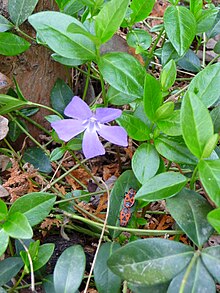Vinca
| Vinca | |
|---|---|

| |
| Vinca minor | |
| Scientific classification | |
| Kingdom: | |
| (unranked): | |
| (unranked): | |
| (unranked): | |
| Order: | |
| Family: | |
| Genus: | Vinca |
| Species | |
|
Vinca difformis | |
Vinca is a genus of six species in the family Apocynaceae, native to Europe, northwest Africa and southwest Asia.[1][2][3] The name is Template:Pron-en,[4] deriving from Latin vincire: "to bind, fetter". The English name periwinkle is shared with the related genus Catharanthus (and also with the common seashore mollusc, Littorina littorea).

They are subshrubs or herbaceous, and have slender trailing stems 1–2 m (3–6 feet) long but not growing more than 20–70 cm (8-30 inches) above ground; the stems frequently take root where they touch the ground, enabling the plant to spread widely. The leaves are opposite, simple broad lanceolate to ovate, 1–9 cm (0.25–3.5 inches) long and 0.5–6 cm (0.25–2.25 inches) broad; they are evergreen in four species, but deciduous in the herbaceous V. herbacea, which dies back to the root system in winter.[5][6]
The flowers, produced through most of the year, are salverform (like those of Phlox), simple, 2.5–7 cm (1–3 inches) broad, with five usually violet (occasionally white) petals joined together at the base to form a tube. The fruit consists of a pair of divergent follicles; a dry fruit which is dehiscent along one rupture site in order to release seeds.[5][6]
Two of the species, Vinca major and Vinca minor, are extensively cultivated as an ornamental plant. Because the plants spread quickly, they are often used as a groundcover. Although attractive, both are sometimes considered weeds, occasionally invasive in some regions where they are not native because of the rapid spreading and the possibility of choking out native species if they enter areas where they are not controlled. Areas affected include parts of Australia, New Zealand, and the United States.[7][8]. In other cases, Vinca has been recommended as a fire retardant ground cover.[9]
Medicinal Use
Vincristine, extracted from Vinca rosea Linn. (Catharanthus), is a type of chemotherapy called a vinca alkaloid used to treat some leukemias, lymphomas and childhood cancers, as well as several other types of cancer and some non-cancerous conditions. Vincblastine is a chemical analogue of Vincristine and also used to treat various forms of cancer.[10]
References
- ^ Flora Europaea: Vinca
- ^ EuroMed Plantbase Project: Vinca
- ^ Flora of Pakistan: Vinca
- ^ Stearn, W. T. (1983). Botanical Latin ed. 3. David & Charles ISBN 0-7153-8548-8.
- ^ a b Blamey, M., & Grey-Wilson, C. (1989). Flora of Britain and Northern Europe. Hodder & Stoughton.
- ^ a b Huxley, A., ed. (1992). New RHS Dictionary of Gardening 4: 664-665. Macmillan.
- ^ Global Compendium of Weeds: Vinca major
- ^ Global Compendium of Weeds: Vinca minor
- ^ Fire-Resistant Plants for Montana Landscapes
- ^ American Cancer Society
-
Vinca minor (above), Vinca major (below); leaves for comparison
-
Vinca minor (above), Vinca major (below); leaf margins for comparison; note hairless margin of V. minor, hairy margin of V. major


